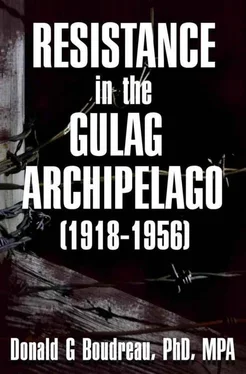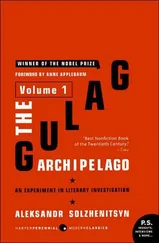Another conscious move by the Stalinist system to eradicate any dissent was to place common thieves in the same cells with the other zek prisoners. Many of the common thieves worked for the prison administration in exchange for amnesty, special privileges, food, clothing and money. Solzhenitsyn observes the conditions conducive to striking out and explains why to a great extent their non-existence. It is also noteworthy that these common thieves not only sought damaging statements from the other zeks which would certainly come back to haunt them in time. They were also notorious for mugging zeks in their cells and stealing their food parcels, clothing and personal valuables. Resistance by the zeks against the thieves when it did occur was in a rage of self-defense, rather than a group effort at resisting.
To strike out boldly, a person has to feel that his rear is defended, that he has support on both his flanks, that there is solid earth beneath his feet. All of these conditions were absent for the Article 58’s. Having passed through the meat grinder of political interrogation, the human being was starved, he hadn’t slept, he had frozen in punishment cells, he had lain there a beaten man. But it wasn’t only his body. His soul was crushed too. Over and over he had been told and had had demonstrated to him that his views, and his conduct in life, and his relationships with people had all been wrong because they had brought him to ruin. And so you allow the thieves to take your overcoat and paw through your jacket and snatch your twenty rubles from where it was sewn in, and your bag has already been tossed up above and checked out, and everything your sentimental wife collected for your long trip after you were sentenced stays up there, and they’ve thrown the bag back down to you with, …your toothbrush. Although not everyone submitted just like that, 99 percent did in the thirties and forties. And how could that be? Men, officers, soldiers, front-line soldiers! [15] Cf. Solzhenitsyn, “Gulag”, at 503-4.
It is said that in 1942 at the Gorky Transit Prison some officer prisoners (including Gavrilov, the military engineer Schebetin, and others) nonetheless rebelled, beat up the thieves, and forced them to stay in line. Another incident is said to have occurred at the Kotlas Transit Prison in 1940. The thieves started grabbing money out of the hands of the political prisoners lined up at the commissary. The politicals began beating up the thieves so badly that they couldn’t be stopped. The guards entered the compound with machine guns to defend the thieves. Solzhenitsyn affirms his belief in this latter occurrence, “now there’s something that rings true. That’s the way it really was.” [16] Cf. Solzhenitsyn, “Gulag”, at 545-6.
The prisoners were still not free even within the confines of their cellblocks. They were also exposed to juveniles. They were still boys, some as young as twelve years old. They had already been processed through a thieves’ trial a la the Criminal Code, and they continued their apprenticeship with their seniors Solzhenitsyn recounts with almost total recall, he and his fellow zeks being jumped by three of them, who then proceeded on in stealing their food parcels.
It took no more than a minute for them to seize the bundles with the fat bacon, sugar and bread. They were gone. We lay there feeling stupid. We had given up our food without a fight. And we could go on lying there now, but that was utterly impossible. Creeping out awkwardly, rear ends first, we got up from under the bunks. [17] Cf. Solzhenitsyn, “Gulag”, at 547.
In persisting to put the Gulag archipelago in its proper perspective, the following is imperative. During the years when the prisoners’ cases did not carry any indication of their final destination, the transit prisons turned into slave markets. The conscientious merchants demanded that the ‘merchandise’ be displayed alive and bare-skinned for them to inspect. “Well, what merchandise have you brought? asked a buyer at Butyrki station, observing and inspecting the attributes of a seventeen-year old girl named Ira kalian. Solzhenitsyn continues in documenting an incident whereby twenty-four officers of the Gulag came for a ‘buy’ at Usman Prison in 1947. All the women prisoners were forced to undress and parade before these officers. Solzhenitsyn observes, “These officers were very seriously selecting bedmates for themselves and their colleagues.” [18] Cf. Solzhenitsyn, “Gulag”, at 562.
Moving along in time, let us now make reference to 1960, when Gennady Smelov, a non-political offender, declared a lengthy hunger strike in the Leningrad Prison. The prosecutor went to his cell and asked him” “Why are you torturing yourself?” And Smelov replied: “Justice is more precious to me than life.” This phrase so astonished the prosecutor that the very next day Smelov was taken to Leningrad Special Hospital (i.e., the insane asylum) for prisoners. And the doctor proceeded to tell him: “We suspect you may be a schizophrenic.” [19] Cf. Solzhenitsyn, “Gulag”, at 473.
As the political scientist Sidney Hook (1965) affirms in Marx and the Marxists: The Ambiguous Legacy , Stalin transformed dialectical materialism in the Soviet Union into dialectical terrorism. [20] Sidney Hook, Marx and the Marxists , pp. 107-22.
The former constituted a view of the world as developing systems based upon the material forces which exist independently of all consciousness, human or divine. The latter, established by Stalin, held that the Central Committee leaders were the only person(s) vested in interpreting dialectical materialism. In brief, this meant that the power to decide what was valid and invalid rested with Stalin. Class enemies would be extirpated vis-a-vis purging.
Continuing along this line, Stalin manifested social fascism in order to achieve hegemony over the working class. [21] Cf. Hook.
All Social democrats were thus the moderate wing of fascism and they were to be destroyed due to their intermittent involvement in Western coalition governments. It appears that, unfortunately, consistency was maintained most methodically with relation to terroristic means. So pervasive was the repression, so fragile the human condition that, dissent had no demonstrative function.
Tyrannous and oppressive governments are as old as mankind. Some human experiences, which occur under them are so traumatic that they leave forever their mark on those who have endured them-and survived. Few, not only feel compelled to recall the events, but thereafter to bear witness, to give testimony, to tell the world what they were like. So it has been and still is with the survivors of Hitler’s holocaust; so, too, with those who lived through the Stalinist reign of terror. Sporadically yet definitively, purposely and accidental, legally and illegally, works bearing witness are emerging out of the Soviet Union, and they have been on the increase since the death of Stalin. None of these Russian writings whether they be fiction, or non-fiction, has received greater attention than the work of Alexander Solzhenitsyn.
Solzhenitsyn’s work presents to a great extent a powerful attack on the Soviet system from inside. He constantly calls into question the morality of the Soviet leaders and their institutions, both high and low. The stress is on ethical rather than socialist principles: Solzhenitsyn’s views are basically moral rather than political, except insofar as ethics are ancillary to politics. As we will observe, Solzhenitsyn is more obsessed by the problem of man’s evil and goodness than he is by the political ramifications of those ethical considerations.
Solzhenitsyn is unable to uncover the roots of evil or of goodness by tracing them to the social system and its production and class relations, by employing the orthodox and vulgar Marxist analysis of base and superstructure.
Читать дальше












